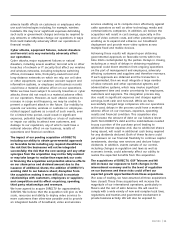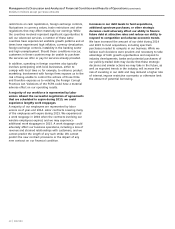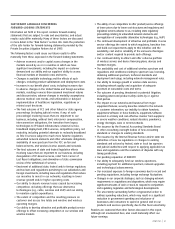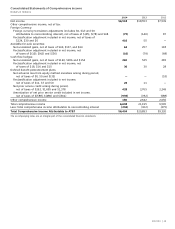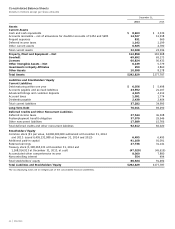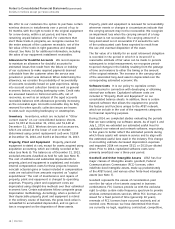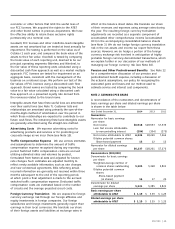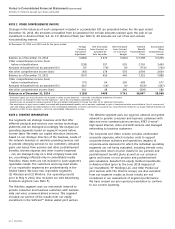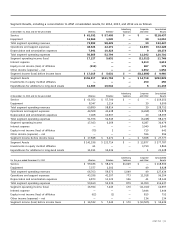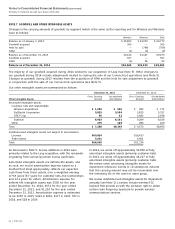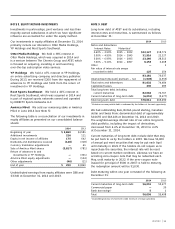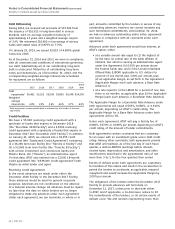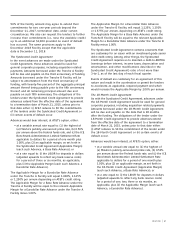AT&T Wireless 2014 Annual Report Download - page 49
Download and view the complete annual report
Please find page 49 of the 2014 AT&T Wireless annual report below. You can navigate through the pages in the report by either clicking on the pages listed below, or by using the keyword search tool below to find specific information within the annual report.
AT&T INC.
|
47
Notes to Consolidated Financial Statements
Dollars in millions except per share amounts
January 1, 2017, recognizing in beginning retained earnings
an adjustment for the cumulative effect of the change and
provide additional disclosures comparing results to previous
rules. We continue to evaluate the impact of the new
standard and available adoption methods.
Income Taxes We provide deferred income taxes for
temporary differences between the carrying amounts of
assets and liabilities for financial reporting purposes and
the computed tax basis of those assets and liabilities.
We provide valuation allowances against the deferred tax
assets for which the realization is uncertain. We review
these items regularly in light of changes in federal and
state tax laws and changes in our business.
Cash and Cash Equivalents Cash and cash equivalents
include all highly liquid investments with original
maturities of three months or less. The carrying amounts
approximate fair value. At December 31, 2014, we
held $1,257 in cash and $7,346 in money market
funds and other cash equivalents.
Revenue Recognition Revenues derived from wireless,
local telephone, long distance, data and video services are
recognized when services are provided. This is based
upon either usage (e.g., minutes of traffic/bytes of data
processed), period of time (e.g., monthly service fees)
or other established fee schedules. Our service revenues
are billed either in advance, arrears or are prepaid.
We record revenue reductions for estimated future
adjustments to customer accounts, other than bad debt
expense, at the time revenue is recognized based on
historical experience. Service revenues include billings
to our customers for various regulatory fees imposed on
us by governmental authorities. We report revenues from
transactions between us and our customers net of taxes
the government authorities require us to collect from our
customers in our consolidated statements of income.
Cash incentives given to customers are recorded as a
reduction of revenue. Revenues and associated expenses
related to nonrefundable, upfront service activation and
setup fees are deferred and recognized over the associated
service contract period or customer life. Generally,
associated expenses are deferred only up to the amount
of deferred revenue. Revenue recognized from contracts
that bundle services and equipment is limited to the
lesser of the amount allocated based on the relative
selling price of the equipment and service already
delivered or the amount paid and owed by the customer
for the equipment and service already delivered. We record
the sale of equipment to customers when we no longer
have any requirements to perform, when title is passed and
when the products are accepted by customers. We record
the sale of equipment and services to customers as gross
revenue when we are the principal in the arrangement and
net of the associated costs incurred when we are not
considered the principal in the arrangement.
NOTE 1. SUMMARY OF SIGNIFICANT ACCOUNTING POLICIES
Basis of Presentation Throughout this document,
AT&T Inc. is referred to as “AT&T,” “we” or the “Company.”
The consolidated financial statements include the accounts
of the Company and our majority-owned subsidiaries and
affiliates. Our subsidiaries and affiliates operate in the
communications services industry both domestically and
internationally, providing wireless communications services,
traditional wireline voice services, data/broadband and
Internet services, video services, telecommunications
equipment, managed networking and wholesale services.
All significant intercompany transactions are eliminated
in the consolidation process. Investments in less than
majority-owned subsidiaries and partnerships where
we have significant influence are accounted for under
the equity method. Earnings from certain investments
accounted for using the equity method are included for
periods ended within up to one month of our year end
(see Note 8). We also recorded our proportionate share
of our equity method investees’ other comprehensive
income (OCI) items, including actuarial gains and losses
on pension and other postretirement benefit obligations.
The preparation of financial statements in conformity with
U.S. generally accepted accounting principles (GAAP)
requires management to make estimates and assumptions
that affect the amounts reported in the financial statements
and accompanying notes, including estimates of probable
losses and expenses. Actual results could differ from those
estimates. Certain amounts have been reclassified to
conform to the current period’s presentation.
New Accounting Standards In May 2014, the Financial
Accounting Standards Board (FASB) issued Accounting
Standards Update No. 2014-09, “Revenue from Contracts
with Customers (Topic 606)” (ASU 2014-09), which replaces
existing revenue recognition rules with a comprehensive
revenue measurement and recognition standard and
expanded disclosure requirements. Upon initial evaluation,
we believe the key changes in the standard that impact
our revenue recognition relate to the allocation of contract
revenues between service and equipment, and the timing
in which those revenues are recognized. ASU 2014-09 also
specifies that all incremental costs of obtaining and direct
costs of fulfilling our contracts with customers should
be deferred and recognized over the contract period or
expected customer life. Currently, we generally defer such
costs only up to an amount equal to any related deferred
revenue. ASU 2014-09 becomes effective for annual
reporting periods beginning after December 15, 2016.
The FASB will allow two adoption methods under ASU
2014-09. Under one method, a company will apply the
rules to contracts in all reporting periods presented, subject
to certain allowable exceptions. Under the other method, a
company will apply the rules to all contracts existing as of




